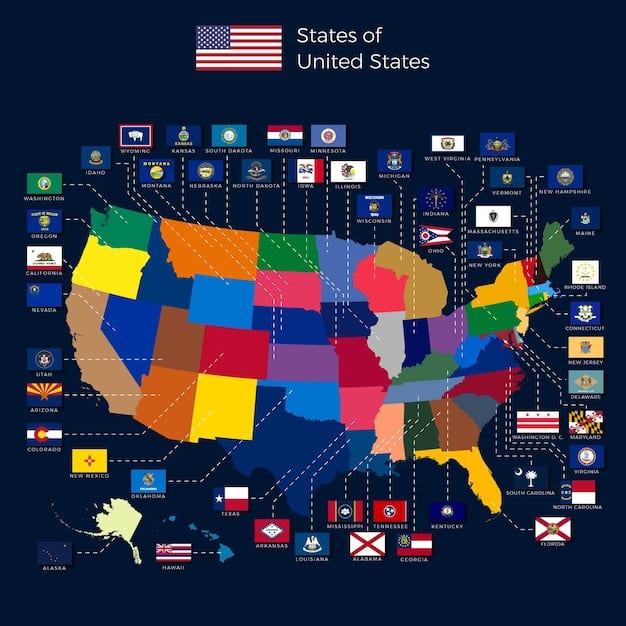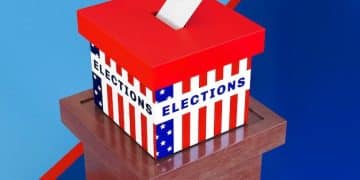Analyzing the Impact of SCOTUS Rulings on 2024 Voting Rights

Analyzing the Impact of Recent Supreme Court Rulings on Voting Rights in the 2024 Election Cycle reveals a complex interplay of legal decisions that may reshape voter access and participation, potentially influencing election outcomes through changes in redistricting, voter ID laws, and campaign finance regulations.
The upcoming 2024 election cycle unfolds against a backdrop of significant legal challenges and shifts in voting rights, largely influenced by recent Supreme Court decisions. This article delves into Analyzing the Impact of Recent Supreme Court Rulings on Voting Rights in the 2024 Election Cycle, examining how these rulings may reshape the electoral landscape.
Understanding the Evolving Voting Rights Landscape
Recent Supreme Court rulings have triggered debates and concerns about potential restrictions on voting rights across the United States. These decisions touch upon various aspects of election administration and voter access, necessitating a comprehensive analysis to fully grasp their implications.
Key Supreme Court Cases Affecting Voting Rights
Several landmark cases have shaped the current voting rights terrain. Understanding these cases is crucial for assessing the potential impact on the 2024 elections.
- Shelby County v. Holder (2013): This decision weakened the Voting Rights Act of 1965 by removing the requirement for certain states with a history of discrimination to obtain federal preclearance before making changes to their voting laws.
- Brnovich v. Democratic National Committee (2021): The Court upheld Arizona’s voting restrictions, setting a precedent that could embolden other states to enact similar measures.
- Possible challenges to the use of redistricting maps: The Court’s approach to partisan gerrymandering cases may affect the fairness of district boundaries and the representation of different groups of voters.
These cases represent pivotal moments in the ongoing struggle to balance election integrity with voter access. What specific impacts might these rulings have on the ground as we approach the 2024 election?

Potential Impact on Voter Turnout in 2024
One of the most significant concerns surrounding these Supreme Court rulings is their potential to suppress voter turnout, particularly among specific demographic groups. This section explores the possible pathways through which these rulings could affect who votes in the 2024 election.
It is hypothesized that states previously subject to federal preclearance under the Voting Rights Act might implement more restrictive voting laws, such as stricter voter ID requirements or limitations on early voting periods. These measures could disproportionately affect minority voters, students, and low-income individuals who may have difficulty meeting these requirements or accessing polling places.
Likely Scenarios for Voter Suppression
How could these rulings play out in practical terms, affecting real voters on Election Day?
- Increased difficulty for minority voters to register and cast ballots due to stricter ID laws.
- Longer wait times at polling places because of reduced early voting options.
- Confusion and uncertainty about voting procedures, leading to accidental disenfranchisement.
The impacts of these occurrences could lead to a significant decline in voter participation, especially in closely contested states. It is important to implement counteractive measures to ensure fair access to the ballot for all eligible citizens.
State Responses and Legislative Actions
In the wake of these Supreme Court decisions, state legislatures have responded in various ways, either by enacting more restrictive voting laws or by attempting to expand voter access through alternative measures. This section examines the different approaches states are taking and the legal battles that may ensue.
Some states have moved to enact stricter voter ID laws, limit early voting, or restrict mail-in voting options, citing concerns about election security. Conversely, other states have sought to expand voter access by implementing automatic voter registration, same-day registration, or online voter registration systems.
Legislative Actions Impacting Voting Rights
- States enacting stricter voter ID laws.
- States limiting early voting periods or accessibility.
- Attempts to expand access through measures like automatic voter registration.
These varied legislative actions create a complex patchwork of voting laws across the country. Litigation is already underway in numerous states, challenging the constitutionality of both restrictive and expansive voting measures, adding further uncertainty to the electoral landscape.

Redistricting Challenges and Gerrymandering
Redistricting, the redrawing of electoral district boundaries, occurs every ten years following the census. This process can have a significant impact on the competitiveness of elections and the representation of different communities. Supreme Court rulings related to gerrymandering, the manipulation of district boundaries for partisan advantage, have further complicated this issue.
The Role of Congressional Maps
The partisan drawing of district lines can either protect incumbents or create opportunities for political gains. How might the Court’s stance on partisan gerrymandering influence the fairness and competitiveness of congressional maps across the country?
Cases involving allegations of partisan gerrymandering have reached the Supreme Court, but the Court has generally avoided establishing clear standards for when a redistricting plan crosses the line into unconstitutional partisan manipulation. This leaves state legislatures with considerable leeway in drawing district lines, potentially leading to maps that disproportionately favor one party over another, diminishing the representation of minority groups and voters of opposing parties.
The Future of the Voting Rights Act
The Voting Rights Act of 1965 stands as a landmark achievement in protecting the right to vote for all Americans. However, recent Supreme Court decisions have significantly weakened key provisions of the Act, raising questions about its future effectiveness. What steps can be taken to strengthen the Act and ensure its continued relevance in protecting voting rights?
Potential Legislative Solutions
- Congressional action to restore the preclearance provision of the Voting Rights Act.
- Updates to the Act to address emerging forms of voter discrimination.
- Increased funding for voter education and outreach programs.
Legislative efforts to bolster the Voting Rights Act face significant political hurdles, but some believe that changes are necessary to safeguard the right to vote and ensure that all citizens have an equal opportunity to participate in the democratic process.
Campaign Finance Regulations and Political Spending
Supreme Court rulings on campaign finance have significantly altered the landscape of political spending in elections. These decisions have allowed for increased contributions from corporations and wealthy individuals, potentially influencing the outcome of elections. This section examines the impact of these rulings on campaign finance and their potential implications for the 2024 elections.
The Court’s rulings in cases such as *Citizens United v. Federal Election Commission (2010)* have unleashed a flood of money into political campaigns, allowing for the creation of Super PACs and other independent expenditure groups that can spend unlimited amounts of money to support or oppose candidates.
Implications for Electoral Fairness
- Increased influence of wealthy donors and corporations in political campaigns.
- The potential for uneven playing fields, where candidates with access to more funding have an advantage.
- Concerns about the transparency and accountability of campaign spending.
Debates continue about the extent to which money influences election outcomes. Some advocate for campaign finance reform, such as limits on contributions and increased disclosure requirements, to promote greater fairness and transparency.
| Key Aspect | Brief Description |
|---|---|
| ⚖️ SCOTUS Rulings | Impact voting laws, redistricting, and campaign finance. |
| 🗳️ Voter Turnout | Affected by voter ID laws, early voting limits, and redistricting. |
| 🗺️ Gerrymandering | Partisan redistricting influences competitive districts. |
| 💰 Campaign Finance | Influenced by Supreme Court rulings, impacting political spending. |
Frequently Asked Questions
▼
This ruling weakened the Voting Rights Act by removing the requirement for certain states to obtain federal preclearance before changing voting laws. This paved the way for states to implement more restrictive voting measures without federal oversight.
▼
Examples include stricter voter ID requirements, limitations on early voting periods, and restrictions on mail-in voting options. These laws can make it more difficult for certain groups of people to register and vote.
▼
Partisan gerrymandering is the manipulation of electoral district boundaries to favor one political party over another. It can lead to less competitive elections and disproportionate representation for the favored party in legislative bodies.
▼
Rulings like *Citizens United* have allowed for increased contributions from corporations and wealthy individuals, leading to a surge in political spending by Super PACs and other independent expenditure groups, influencing elections.
▼
Potential solutions include congressional action to restore the preclearance provision, updating the Act to address new forms of voter discrimination, and increasing funding for voter education and outreach programs for all citizens.
Conclusion
Analyzing the Impact of Recent Supreme Court Rulings on Voting Rights in the 2024 Election Cycle reveals a complex and evolving legal landscape. The impact of these rulings may significantly, alter voter access and participation in 2024, highlighting the importance of ongoing legal challenges and legislative efforts to protect the rights of all voters.





